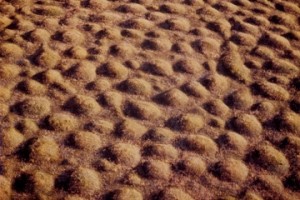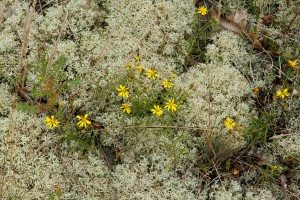By Castilleja Kuzis
Welcome to The Pacific Northwest Prairie Lichen Restoration Project blog. As a part of the 2015 Evergreen State College course Bryophytes and Lichens of The Pacific Northwest, we will be undertaking experimental research in prairie lichen restoration. This blog will serve to communicate the importance, challenges, current research, and eventually our experiments and findings. We hope you enjoy reading as much as we enjoy the opportunity to learn.
Why does it matter?
The South Puget Sound area was once covered with over a hundred thousand acres of unique prairies. Formed by glacial outwash, the gravelly soil of the prairies does not support the growth of tall tress. These once vast open expanses were colonized by native bunch grasses, wildflowers, butterflies and small mammals, and were maintained by the Native Americans through controlled burns to preserve open space for the plants they depended on for food and medicine. Today prairies are the most endangered habitat in Washington. Fish and Wildlife Biologist for Joint Base Lewis-McChord, Jim Lynch, estimates “90% of the original prairie has been converted to agriculture, urban area or conifer forests.” Prairie habitats are a specialized ecosystem that support some unique species including the Taylor’s Checkerspot (Euphydryas editha taylori), the Streaked Horned Lark (Eremophila alpestris strigata), and the Mazama Pocket Gopher (Thomomys mazama), all of which are listed as threatened or endangered and depend on this shrinking habitat. Fortunately, some of the largest tracts of prairie habitat lie within the Joint Base Lewis-McChord and the base is working with conservation groups such as South Puget Sound Prairies to manage operations and protect these habitats. Check out the South Puget Sound Prairie site or a great video to learn more:
http://www.southsoundprairies.org/who-we-are/
What about the lichen?
Wildflowers growing from Cladonia Mat, Photo: Tom Potterfield
Lichens are a symbiotic relationship between a fungus and algae, a fungus and cyanobacteria or both. This unique partnership takes on many forms and lichens can be found on rocks, trees, the ground, and in some of the harshest conditions on earth. What we are concerned with is their ability to form mats, and in addition to other native ground dwelling moss and algae, form cryptogamic or living crusts on the soil. These are the glue that hold the bunchgrass prairie ecosystem together (Goward 1991). Lichens provide ground cover, aid in moisture retention, inhibit invasive species, and numerous native species are dependent on lichen as a food source (Smith et. al. 2012).
In addition lichens present many potential research applications. Some species are sensitive to air quality and environmental pollution and can be used in bio monitoring. Lichens also produce unique and unusual compounds that aid their survival and can have antibiotic, antiviral and other therapeutic properties (Johnson et al. 2011). In recent studies, lichen extracts have been shown to be able to degrade prions, or the malformed proteins responsible for transmissible spongiform encephalopathy such as mad cow disease or chronic wasting disease in deer. (Johnson et. al. 2011).
What’s being done?
Research in restoration and management of prairie ecosystems has shown lichen plays an important but little understood role in maintaining biodiversity of native plant communities. Studies in Newfoundland of re-vegetation of former mining sites found that plant growth increased when lichen and moss propagules were distributed with the native plants (Campeau and Blanchard 2010). Closer to home, research by Evergreen Environmental Science Masters student Sasha Porter has shown communities of mycorrihzal fungi help support growth of key native plant species (Porter 2014). Lichens not only contain a fungal aspect that could demonstrate similar assistance to vegetation, cyanolichens are even capable of fixing nitrogen which provides important resources for plants in the nutrient poor prairie soil. There has been limited research into the lichens communities that occur in the prairie habitats, the first comprehensive checklist of lichens and bryophytes for Pacific Northwest prairies was only recently published and in addition documented four rare and endangered species of lichen (Calabria et. al. 2015).
Looking ahead it seems future conservation and restoration planning for the south Puget Sound prairies should consider the role of lichens. Yet, lichen restoration and research is an area with unique challenges. Not only are lichens extremely substrate specific, slow growing, and sensitive to fire and air quality, but research into their diversity, abundance, and role in the prairie ecosystem is only beginning to be explored.

Aerial Photo of Mima Mounds, Photo: Washington Department of Natural Resources
While we didn’t find specific studies on reintroduction methods of Pacific Northwest prairie lichens there have been multiple efforts in our region regarding management tactics for the preservation of prairie lichen focused at the Mima Mounds Natural Preserve in Southwestern Washington. This is a unique bioregion with characteristic geologic formations. Studies conducted by the Oregon State University Department of Botany and Plant Pathology, and students out of Eastern Washington University found that low intensity prescribed burns can support prairie lichen communities by maintaining open canopies, yet lichens are extremely fire sensitive and can take decades to even begin to reestablish after fires (Smith et al. 2011;Anicito 2013). We know that the native Americans managed the south Puget Sound Prairies with fire and that the low intensity fire regime is an important part of many of the other native plant and animal life cycles. We are looking forward to exploring the role of lichens in this complex ecosystem.
What are we going to do?
Stay tuned to find out!
References
Anicito, Kristin R. 2013. A holistic approach to Mima Mound Prairie Restoration. Eastern Washington University Masters Thesis Collection. Paper 115.
Calabria, L. M.; Arnold, A.; Charatz, E.; Eide, G.; Hynson, L. M.; Jackmond, G.; Nannes,J.; Stone, D. And Villella, J. 2015. A Checklist of Soil-Dwelling Bryophytes and Lichens of the South Puget Sound Prairies of Western Washington. Evansia 32(1); 30-41.
Campeau, S., and Blanchard, K. 2010. Use Of Locally Sourced Moss, Lichen and Vascular Plant Propagules For The Revegetation of Mineral Disturbances in a Boreal Climate, In: British Columbia Mine Reclamation Symposium 2010, https://circle.ubc.ca/handle/2429/30115.
Goward, T. 1991. The Enlichenment: Lichens and the Vanished Grasslands. B.C. Naturalist (29) 6; 8-9.
Johnson CJ, Bennett JP, Biro SM, Duque-Velasquez JC, Rodriguez CM, Bessen RA, et al. 2011. Degradation of the disease-associated prion protein by a serine protease from lichens. Jason C. Bartz, Editor, PLoS One. 2011;6:e19836.
Porter, 2014. Mycorrhizal and Microbial Inoculation Affect the Growth and Survival of Native Plants Raised for Restoration. The Evergreen State University Masters Thesis.
Smith, R. J., Alphandary, E., Arvidson, R., Bono, G., Chipman, B., Corkery, A., DiMeglio, J., Hansen, K., Isch, K., McAlpine, J., Marks-Fire, C., Mead, B., Miller, D., Nolte, N., Ottombrino, A., Prior, T., Streich, J., Theis, S., Vandruff, Sc. Wessler, C., Wessler, K., Wiseman, M. and B. McCune. 2012. Rare inland reindeer lichens at Mima Mounds in Southwest Washington State. North American Fungi 7: 1-25.
Photo credits: Tom Potterfield- labeled for non-commercial reuse https://www.flickr.com/photos/tgpotterfield/10829737116
Washington Department of Natural Resources- labeled for non-commercial reuse
https://www.flickr.com/photos/wastatednr/


Recent Comments